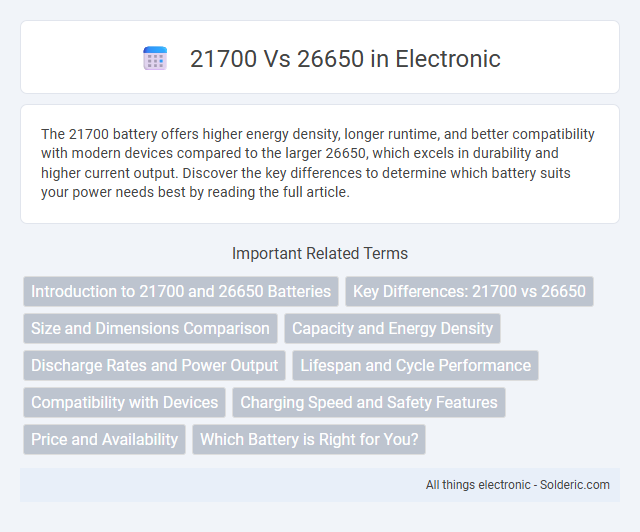The 21700 battery offers higher energy density, longer runtime, and better compatibility with modern devices compared to the larger 26650, which excels in durability and higher current output. Discover the key differences to determine which battery suits your power needs best by reading the full article.
Comparison Table
| Feature | 21700 Battery | 26650 Battery |
|---|---|---|
| Dimensions | 21mm diameter x 70mm length | 26mm diameter x 65mm length |
| Capacity | 3000-5000mAh | 4000-6000mAh |
| Voltage | 3.6V - 3.7V nominal | 3.6V - 3.7V nominal |
| Discharge Rate | Up to 30A continuous | Up to 20A continuous |
| Weight | 60-70g | 70-90g |
| Applications | Electric vehicles, power tools, high-performance devices | Flashlights, e-bikes, high-drain applications |
| Energy Density | Higher energy density | Lower energy density |
Introduction to 21700 and 26650 Batteries
21700 and 26650 batteries differ primarily in size and capacity, with the 21700 measuring 21mm in diameter and 70mm in length, while the 26650 is larger at 26mm diameter and 65mm length. The 21700 is favored for high-energy density applications such as electric vehicles and portable electronics due to its balance of capacity and compactness, whereas the 26650 offers higher current output and durability, making it suitable for high-drain devices like flashlights and power tools. Your choice between these batteries will depend on the specific requirements for energy storage, size constraints, and power delivery in your device.
Key Differences: 21700 vs 26650
The 21700 and 26650 batteries differ primarily in size, capacity, and compatibility with devices. The 21700 battery typically measures 21mm in diameter and 70mm in length, offering a balanced capacity around 4000-5000mAh, while the larger 26650 battery measures 26mm by 65mm, providing higher capacity up to 6000-7000mAh. Your choice depends on device requirements; 21700 is favored for compact, high-drain electronics, whereas 26650 suits applications demanding extended runtime and higher power.
Size and Dimensions Comparison
21700 and 26650 batteries differ significantly in size and dimensions, with the 26650 measuring approximately 26mm in diameter and 65mm in length, whereas the 21700 is smaller at around 21mm in diameter and 70mm in length. This size difference impacts battery capacity and device compatibility, as 26650 cells typically offer higher capacity but require more space. When choosing between the two, consider your device's size constraints and energy needs to determine which battery fits your application best.
Capacity and Energy Density
The 26650 battery typically offers a higher capacity ranging from 4000mAh to 6000mAh, compared to the 21700's 3000mAh to 5000mAh, making it suitable for devices requiring longer run times. Energy density favors the 21700 cell due to its more compact size and advanced chemistry, delivering more power per unit volume and weight. Your choice depends on whether you prioritize total capacity for extended use or higher energy density for a lighter, more efficient power source.
Discharge Rates and Power Output
The 26650 battery typically offers higher discharge rates, making it suitable for applications that require sustained high power output, such as high-performance flashlights and power tools. The 21700 battery, while slightly smaller, provides a good balance of discharge rate and capacity, delivering efficient power output for devices like electric vehicles and laptops. Your choice depends on whether you prioritize higher peak current delivery with the 26650 or a more compact design with reliable discharge performance found in the 21700.
Lifespan and Cycle Performance
The 21700 battery typically offers a lifespan of 300 to 500 charge cycles, maintaining consistent capacity due to advanced lithium-ion chemistry, while the 26650 battery often provides slightly fewer cycles, around 250 to 400, because of its larger size and different cell construction. Cycle performance of the 21700 excels in energy density and stability, making it suitable for high-drain devices, whereas the 26650, with its higher capacity, can sustain longer discharge times but may degrade faster under frequent cycling. Optimal use and charging conditions can extend both batteries' lifespans, but the 21700 is generally favored for longevity and cycle efficiency in high-performance applications.
Compatibility with Devices
The 21700 battery offers broad compatibility with modern high-drain devices such as electric vehicles, power tools, and high-capacity flashlights, while the 26650 is typically favored in larger devices requiring extended runtime like high-power flashlights and some laptops. Many devices designed for 26650 batteries do not support 21700 due to differences in size and voltage, though adapters can sometimes bridge this gap. Compatibility depends heavily on the device's battery compartment dimensions and power requirements, highlighting the importance of matching battery specifications precisely.
Charging Speed and Safety Features
The 21700 battery generally offers faster charging speeds due to higher discharge rates and improved chemistry compared to the 26650, making it ideal for high-drain devices. Safety features in 21700 cells often include advanced protection circuits to prevent overcharging, overheating, and short circuits, enhancing user safety. In contrast, 26650 batteries tend to have lower charging speeds and fewer integrated safety mechanisms, which can impact their suitability for modern electronic applications.
Price and Availability
21700 batteries generally offer a better balance of price and availability due to their widespread adoption in electric vehicles and high-demand electronics, resulting in competitive pricing and easier access. 26650 batteries tend to be pricier and less commonly stocked, since their niche applications limit mass production and distribution. When choosing between the two, Your decision on price sensitivity and availability needs will significantly impact the most cost-effective and accessible battery option.
Which Battery is Right for You?
The 21700 battery offers a balanced combination of higher energy density and compact size, making it ideal for portable devices and electric vehicles where space and weight are crucial. The 26650 battery provides greater capacity and longer runtime, suited for high-drain applications like flashlights and power tools that demand extended performance. Your choice depends on whether you prioritize battery longevity and size or maximum energy storage for your specific needs.
21700 vs 26650 Infographic

 solderic.com
solderic.com